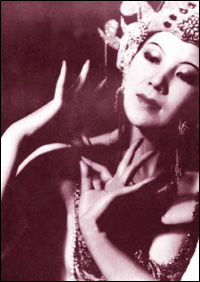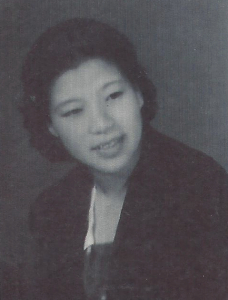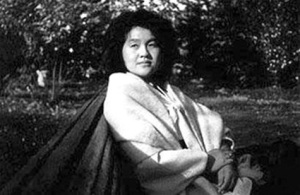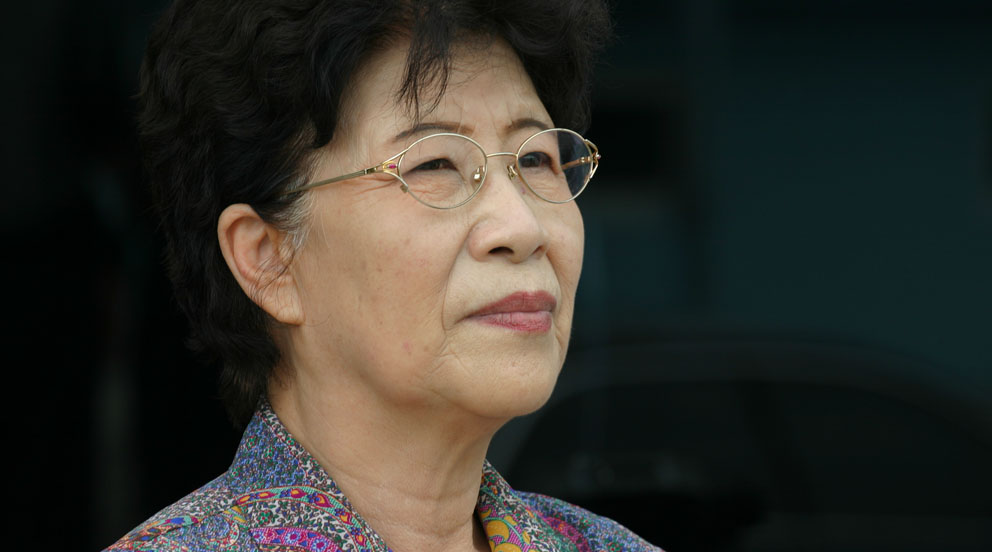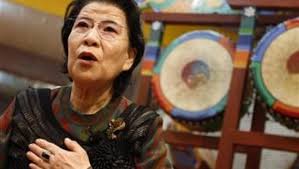Kim Young-soon
Performing Artist living in Seoul, South Korea
Kim Young-soon is a choreographer and dancer living in South Korea since 2003.
Born in Shenyang, China in 1937, Kim Young-soon and her family moved to Korea when she was 8-years-old after her older brother moved to Pyongyang. He established himself as a member of the Worker’s Party and the Communist Party and was a revered general for helping capture Seoul during the Korean War.
Living in Korea between 1945 and 1950 was the “golden period”; it was secure economically and the arts flourished. Kim Young-soon and her family were part of the country’s elite. They occasionally received gifts from Kim Il-sung (1948-1994), the founder of the country’s ruling dynasty, and met him and the heir apparent Kim Jong-il at cultural events. Kim Young-soon believed that Kim Il-Sung was a great leader and she pledged her allegiance and loyalty to the Kim family.
Kim Young-soon studied at Pyongyan Arts University, training under Choi Seung-hee (above), whom she considered to be the best Asian dancer of the 20th century. After graduating, Kim Young-soon worked for 13 years as a dancer in the Korean People’s Army Performance Troupe. She was also the director of commerce for the Foreign Tourist Agency in the Botonggang district in Pyongyang.
By 1970, life was full for Kim Young-soon. She was married, retired from dancing, working at a shop for foreigners, and a young mother raising four children. But life would change dramatically beginning the first of August. While working, the party secretary told Kim Young-soon to pack her bags for a business trip to Sinuiju. Waiting at the station for train number 34, Kim Young-soon was approached by a two-star general who asked for her identification and business travel permit. He asked her to go to an awaiting jeep, and was driven to an unknown building, which she later learned was part of thte Bowibu, the national security agency. They told her to undress and put on a garment worn by patients. Two guards stood outside the room. Inside there was a toilet, a sink, and a bed. She was told to sleep. But she couldn’t. She was there for one week before two security agents told her to write down details about the last 34 years of her life—who she knew, who she talked to, the names of officials with whom she was acquainted. For two months, while her family knew nothing of her whereabouts since she left for that business trip, she was held at Bowibu and investigated. The first of October, at the conclusion of the investigation, Kim Young-soon was called a criminal and arrested, though she was not told of the charge. She and her her 70-year-old parents, and four young children were taken to the Yoduk Political Prison Camp. Her husband disappeared on July 4, 1970, a month before she was taken to the Bowibu.
The family lived together in one of the camp’s small houses where they slept on a clay floor. They ate little—corn and salt. While in the camp, her parents died of malnutrition. Her 23-old son was shot and killed while trying to escape. Her nine-year old son drowned crossing the river near the camp. She found his body in the yard. Kim Young-soon endured starvation, hard labor, and abuse, surviving the camp after nearly nine years. At age 43, she was released only after pleading with an official who was friends with her brother, the North Korean war hero. Granted amnesty, she was transferred to the Jangjin gold mine near Hamhung in South Hamkyung province, and then moved to Hamhung after she bribed an officer.
Hamhung where she worked for three years in a gold mine that was owned by Kim Il-sung. Then she successfully bribed an officer and moved to Hamhung.
While living in Hamhung in 1982, she was summoned by the Pyongyang National Security Agency for a meeting. An agent drove Kim Young-soon to the National Security Agency building in Hamgyong Nam-do. She could not imagine why they wanted to see her–it had been three years since she was released from Yoduk. The agents wanted to make clear to Kim Young-soon that Song Hye-rim was not the wife of Kim Jong-il and that she did not give birth to their son. They were emphatic that she would never be forgiven if she repeated these rumors, these “lies”. This was the moment she understood why she was arrested 19 years earlier: during her initial interrogation at Bowibu she wrote about her friendship with Sung Hye-rim and the secret relationship she had with Kim Jong-il.
After the meeting, she went home and for a week she worried that they would come for her again. She realized she was under surveillance and she would have to leave Korea. It took 12 years for her to realize her plan. Kim Young-soon bought a fake travel permit and military identification and escaped on February 1, 2001 for China. She stayed there for 2-1/2 years working in a restaurant and as a maid. And in 2003, she made her way to South Korea, traveling through Cambodia and Vietnam. She found freedom.
Kim Young-soon (above, left) and Sung Hye-rim (above, right) were students and best friends in school in the 1950s. Her friend was studying acting while she was studying dance. They each grew into well-known artists, Kim Young-soon the dancer and Sung Hye-rim the actress and movie star. One day in 1969, they met and Sung Hye-rim told that she was moving into “special residence number 5”, which Kim Young-soon knew was the home of the ruling Kim family.
The mere act of knowing this secret was a danger to anyone who knew it. The party believed the information was a threat to the Kim dynasty. The elder Kim Il-Sung disapproved of his son’s mistress because of her ties to the south and because she was a divorced woman. He made it clear that Kim Jung-il was to marry and produce a lineage for the dynasty…but not with Sung Hye-rim. The Kim dynasty never officially acknowledged Sung Hye-rim or her relationship with Kim Jong-il. Sung Hye-rim and Kim Jong-il had a son in 1971, named Kim Jong-nam (who was murdered by poisonous needle in Malaysia on February 13, 2017). It is believed that Kim Il-sung did not know about the baby until 1975. Meanwhile, in 1974, Kim Jon-il married the former dancer Ko Young-hee who was acknowledged as his official wife. They had two sons, one named Kim Jong-un who rules North Korea today. After President Kim il-Sung died in 1994 Kim Jong-il took power, reigning until his death in 2011. Human Rights Watch designated his government as “among the world’s most repressive” in every segment of life—political, social, economic, and cultural.
Kim Young-soon’s losses are great. She says that Kim Jong-il stole her life. In addition to losing her parents and two sons, after her release from Yoduk, Kim Young-soon adopted out her 17-year-old daughter to a farmer for a better life. At the time of this interview (October 2014), Kim Young-soon’s daughter is now 54. She has no idea where her daughter is. Her surviving son escaped with his mother, crossing the Tumen River into China in 2001. A year later, he was caught by the Chinese police and forced to return to North Korea. A year after that he met up with his mother in Hanoi, Vietnam, where they fled together to South Korea in 2003. He is disabled, suffering lung damage that resulted from abuse by the Chinese police during his forced return. He is 44. Kim Young-soon has not seen her husband for 45 years. She has no idea what happened to him the day he disappeared in 1970.
Since moving to South Korea, Kim Young-soon is the director of the Choi Seung-hee Dance Education Institute where she teaches her students all there is to know about Choi Seung-hee. She wants to pass on Choi Seung-hee’s legacy to the next generation of Korean dancers.
Kim Young-soon wrote an autobiography in 2009 titled “I was Hye-rim Sung’s Friend” and was a choreographer for the 2006 musical “Yoduk Story” directed by North Korean Jung Sung San. The director began writing the story in 2002 after he successfully escaped North Korea for the south. At the same time he learned that his father was publicly stoned to death in North Korea. He faced death threats and government pressure to modify the story and financial supporter dropped out. Determined to launch the production, he put up his kidney as $20,000 collateral. The production was released in 2006, traveling Washington, DC, New York, and Los Angeles.
A relentless human rights activist, Kim Young-soon is the president of the Association of North Korean Political Victims and their Families; female president of the Committee for the Democratization of North Korea; president and director of dance of the Association of North Korean Defector Artists; member of the board of directors of the Movement for the Democratization of North Korea; and director of operations for Free North Korea Radio. On permanent record is Kim Young-soon testimony before the Commission of Inquiry on Human Right in the Democratic People’s Republic of Korea, August 21, 2013.
Translation:
After I was released from Yoduk Political Prison Camp, I was relocated to a gold mine. I worked there for about three years, when I gave a bribe to an officer and I moved to Hamhung where would end up living for 19 years. In 1989, a director of the Bureau of Counter Intelligence came to me.
In August 1989, I was taken to a state security agency office in Hamgyong Nam-do in the South Hamgyong province. I was so scared because I already spent my time in Yoduk Prison Camp for nine years, then state security agent hold me again, I was so scared. When I got to their office, there was a state security agent . . . he was number two in the security department. He told me, “Song Hye-rim was not the wife of Kim Jong-il and Kim Jong-il and Song Hye-rim did not have his son. That is all groundless rumors, so if you tell about these things again, you’ll not be forgiven”.
At the time I knew that that was the reason why I was taken to Yoduk Prison Camp. Up to that time, I did not know why I was imprisoned. No one told me before. I wondered, how could they know I am here now? How could they know that I was released from Yoduk? How could they find me now? At that time, I knew that I had to escape from North Korea. It took me more than 10 years for me to find my way to South Korea.
Translation:
In the 1970s, there was the National Ballet. They performed famous ballets such as Swan Lake, The Nutcracker, and La Esmeralda. \When Kim Jung-il started heading the Propaganda and Agitation Department, he emphasized North Koreans own cultures, which was considered as a great power. Before Kim Jung-il, we could perform all kinds of good art like Chopin, Anna Karenina, Beethoven, and Tchaikovsky. After Kim Jung-il, we were not allowed to play this music.
Translation:
If I were in North Korea now, I could not even think like this. Since 1970s, I was labeled as a reactionary, I was in prison in Yoduk Political Prison Camp, I think I graduated from the best life college, best life class, so now I can feel that I live in freedom. . Since I fled to South Korea, I could enjoy the human rights and I could share everything with people. I have nothing to fear because I already been through Yoduk Political Prison Camp.
I love freedom. I’ve gone through many hardships and finally made it to South Korea. So there is nothing to fear. I don’t want to waste my time, even one second, and I would do my best for the rest of my life in South Korea where basic human rights are protected.

